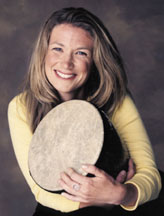"Drumming is essentially a social behavior. When we connect with other humans through rhythm, devoid of race, culture and prejudice, there is something pure and compelling about it. Circle drumming is very social, very human."
- Joseph Walker, High School Principal
Circle - (noun) revolving about a common center. (Mirriamwebster.com)
Calling in the Circle
The artistry of the drum circle really begins before any drumbeats are heard. It begins with how you get the word out. The way you communicate about the drum circle has a huge impact on who will join and what they will expect. For posters, emphasize the great benefits of being part of a drum circle:
- Fun
- Self-expression
- Stress reduction
- Social interaction and community building
- Exercise for mind, body, and spirit
- Camaraderie and support
- Multi-generational family activity
- Develop key musical skills; such as rhythmicity, improvisation, and ensemble
Make sure to include key phrases like:
- Instruments provided, OR, Please bring your own drums and percussion.
- No prior musical experience necessary.
- All levels welcome.
- All ages welcome.
Enlist key pollinators in your community, people who can get the word out. Think outside the box. For a women's drum circle, send emails or flyers to the college campus women's studies program. And don't be discouraged by a low attendance the first time. When they happen regularly, drum circles have a natural tendency to grow (for more ideas, go to www.remo.com, click on "drum circles," and click on "start your own.").
Setting the Circle
Since the beginning of humankind, people have gathered in circles for an important reason. The circle creates community. There is no hierarchy. A sense of equality prevails. The circle is a container for powerful transformation, a vehicle to build up community and celebrate life.
To set up your circle, start by establishing the center. Place a drum or other marker in the middle and place chairs (preferably ones without arms) equidistant from the center. Even standing circles benefit by having a centerpiece, such as a blanket, to focus on. The center of the circle is not a "stage." It is empty, waiting to be filled by the energy of the group, the facilitator, and perhaps a few dancers along the journey. Leave space for entry paths into the circle and remember to make room for wheelchair seating. No one likes feeling cramped, so allow space between chairs for people to be comfortable and not feel "forced" into more intimacy than they're willing to gamble. If you have a drum circle of thirty or so, you may want to have one big circle. If you are working with larger groups, concentric circles help everyone hear each other's beat. Even after everyone arrives, there may be an empty chair or two. Don't be too quick to pull these chairs away. Empty chairs often represent "the ancestors." Welcome their presence into your circle and the music will soar.
|
Coping with non-circular settings.
Ovals and Squares - Invite people to switch places throughout the drum circle to create more mixing. Position the bass drums and bells closest to center point. Fill in the longer spaces with people sitting on floor.
Stages, churches, and performance venues - You may begin on stage, but gradually move to the center of the floor and ask everyone to turn towards you. You can create an immediate sense of circle. If you must be on stage, invite some brave souls to join you.
Rooms with large pillars - Make sure everyone can see your cues. Don't place chairs behind pillars in the "blind spot" of the facilitator.
|
Creating Your Team
Many more people than the facilitator alone compose the successful drum circle. You will need to create an inner circle to support the outer drum circle experience. Utilize your human resources to amass a team for the following roles;
| Job |
Description |
| Set up |
Arranging drums and chairs to help set up the circle. |
| Greeters |
Welcoming people as they enter. It helps to see a smiling face first thing when you arrive. They also remind people to remove their rings before drumming. |
| Designated Drum Distributors (DDDs) |
Roving around the circle making sure everyone has an accessible instrument to play. They also look for people who need assistance with their drum, need mallets, or want to try a new instrument. |
| Rhythm Allies |
People you can count on who can support the groove or play bass drum or bells. |
| Tear down |
People to help collect instruments and put the equipment away. |
***Remember to thank and acknowledge your drum circle team. That's an element of the art of facilitating that should never go unheard.
The Art of Drum Circles is excerpted with permission from The Heart and Art of Drum Circles by Christine Stevens, published by Hal Leonard, 2003.
|
For more information on drumming and drum circles as well as drums and percussion instruments, visit Remo Health Rhythms
|
| Christine Stevens is an international speaker, music therapist, and author. A modern-day troubadour, she introduces people all over the world to the power of musical expression. As......more |  |
|
|
Popular Related Articles/Areas
Popular & Related Products
Popular & Featured Events
Dimensions of Wellness
|
|